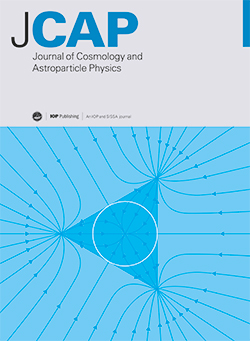EAGLE 模拟中暗物质尖峰发出的伽马射线
IF 5.3
2区 物理与天体物理
Q1 ASTRONOMY & ASTROPHYSICS
Journal of Cosmology and Astroparticle Physics
Pub Date : 2024-09-01
DOI:10.1088/1475-7516/2024/09/005
引用次数: 0
摘要
质量范围在100 M⊙和106 M⊙之间的中等质量黑洞(IMBHs)预计会被高暗物质密度所包围,即所谓的暗物质尖峰。在这些尖峰中,高密度的自湮灭弱相互作用大质量粒子(WIMPs)会产生大量伽马射线。因此,足够近的 IMBHs 可以作为未识别的伽马射线源出现。然而,IMBH 的数量及其在我们银河系中的分布目前还不清楚。在这项工作中,我们提供了从EAGLE模拟中获得的IMBH及其暗物质峰的模拟目录。在EAGLE模拟中,质量为105 M⊙/h的黑洞被播种到质量大于1010 M⊙/h的光环中心,以模拟影响星系形成的黑洞反馈。这个目录包含了大约 150 个类似银河系的星系中约 2500 个 IMBH 的坐标和暗物质峰参数。我们预计银河系内大约有 15+9-6 个 IMBHs,主要分布在银河中心和银河平面。在最乐观的情况下,我们发现目前和未来的伽马射线观测站,如费米-LAT、H.E.S.S.和CTAO,都有足够的灵敏度来探测IMBH周围的暗物质自湮灭截面,其质量从GeV到TeV的暗物质粒子的热遗迹截面要低很多个数量级。我们已经公开了IMBH模拟目录和我们分析的源代码,为利用当前和即将到来的伽马射线观测站研究IMBH周围的暗物质自湮灭提供了资源。本文章由计算机程序翻译,如有差异,请以英文原文为准。
Gamma rays from dark matter spikes in EAGLE simulations
Intermediate Mass Black Holes (IMBHs) with a mass range between 100 M⊙ and 106 M⊙ are expected to be surrounded by high dark matter densities, so-called dark matter spikes. The high density of self-annihilating Weakly Interacting Massive Particles (WIMPs) in these spikes leads to copious gamma-ray production. Sufficiently nearby IMBHs could therefore appear as unidentified gamma-ray sources. However, the number of IMBHs and their distribution within our own Milky Way is currently unknown. In this work, we provide a mock catalogue of IMBHs and their dark matter spikes obtained from the EAGLE simulations, in which black holes with a mass of 105 M⊙/h are seeded into the centre of halos greater than 1010 M⊙/h to model black hole feedback influencing the formation of galaxies. The catalogue contains the coordinates and dark matter spike parameters for about 2500 IMBHs present in about 150 Milky Way-like galaxies. We expect about 15+9-6 IMBHs within our own galaxy, mainly distributed in the Galactic Centre and the Galactic Plane. In the most optimistic scenario, we find that current and future gamma-ray observatories, such as Fermi-LAT, H.E.S.S. and CTAO, would be sensitive enough to probe the cross section of dark matter self-annihilation around IMBHs down to many orders of magnitude below the thermal relic cross section for dark matter particles with masses from GeV to TeV. We have made the IMBH mock catalogue and the source code for our analysis publicly available, providing the resources to study dark matter self-annihilation around IMBHs with current and upcoming gamma-ray observatories.
求助全文
通过发布文献求助,成功后即可免费获取论文全文。
去求助
来源期刊

Journal of Cosmology and Astroparticle Physics
地学天文-天文与天体物理
CiteScore
10.20
自引率
23.40%
发文量
632
审稿时长
1 months
期刊介绍:
Journal of Cosmology and Astroparticle Physics (JCAP) encompasses theoretical, observational and experimental areas as well as computation and simulation. The journal covers the latest developments in the theory of all fundamental interactions and their cosmological implications (e.g. M-theory and cosmology, brane cosmology). JCAP''s coverage also includes topics such as formation, dynamics and clustering of galaxies, pre-galactic star formation, x-ray astronomy, radio astronomy, gravitational lensing, active galactic nuclei, intergalactic and interstellar matter.
 求助内容:
求助内容: 应助结果提醒方式:
应助结果提醒方式:


